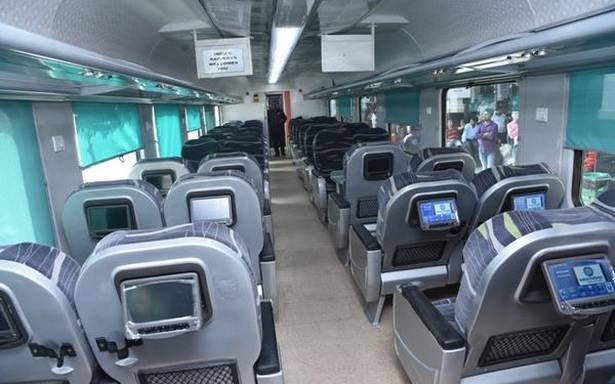Indian Railways
constantly efforts for the redevelopment of its old, discarded locomotives and
to bring such a locomotive on the platform which satisfies the modern
technology needs. We can also see the needs of electrification of Indian routes
and with this, the needs of electric locomotives in India. Also to promote the
MAKE IN INDIA campaign, the railways can become only the big source. So to
catch up all the necessary needs of the nation, The DIESEL LOCOMOTIVE WORKS
(D.L.W.) made an effort and created such a locomotive which creates a big
history in railways technology by forming the locomotive, named WAG C3.
INTRODUCTION
The WAG C3 (WIDE
AC-TRACTION GOODS CLASS-C3) is an AC-electric tractioned freight locomotives
manufactured totally by the DIESEL LCOMOTIVE WORKS (D.L.W.) on 15 APRIL, 2018.
The locomotive had been created by the engineering efforts of D.L.W, RDSO and
BHEL. The locomotive has an identical twin-section parts, each having the power
output of 5000HP thus making the total of 10000HP; which receives its power
from 25KV O.H.E. cable through pantograph.
The WAG C3 locomotive
marks a big turning point in history of INDIAN RAILWAYS and shows the one of
the biggest engineering accomplishment by the railway engineers. Actually this
locomotive is the complete transformation of a DIESEL LOCOMOTIVE into an
ELECTRIC LOCOMOTIVE which has not yet been done by any of the country. Also
this locomotive is completely transitioned by D.L.W. engineers and becomes the
first MAKE IN INDIA project for INDIAN RAILWAYS.
 |
| WAG C3 FIRST MAKE OUT |
DEVELOPMENT
The WAG C3 locomotive
is an electric powered locomotive whose chassy design is same as that of
locomotive from which it is developed. The WAG C3 locomotive is the hybrid of a
diesel locomotive WDM 2 and an electric locomotive WAM 4 in which the body
design is completely inspired from the diesel locomotive WDM 2 and the whole
engine design is taken from the electric locomotive WAM 4.
 |
| WAM 4 |
 |
| WDM 2 |
The frontal body of
the locomotive is exactly same as the as WDM 2 which is to be converted, while
the back body of the locomotive is made same as WAM 4. The concept body of WAM
4 is very important because the loco has to converted into electric while the
body of WDM 2 is taken because the engineers took the aim of converting it into
electric. The top roof of the locomotive is also taken from WAM 4 for allow the
easy installation of the pantograph over it.
The locomotive is used
in twin combined sections just as same as WAG 12 design because it makes the
power of locomotive double. Also, it becomes the powerful electric locomotive
manufactured by the Indian Railways as its processor WAG 9 has only the power
output of 6350HP. The locomotive is manufactured for hauling of the freight
trains but in the future, it can also haul the passenger’s trains.
 |
| BACK VIEW |
FUTURE ASPECT
With this successful
accomplishment, the D.L.W. producing unit made a new project of converting the
next diesel engine, WDP 4 into the same electric locomotive. Let’s hope if we
can find the next converted locomotive in the future.
SPECIFICATIONS
POWER OUTPUT: 10000HP
BUILDER: DIESEL
LOCOMOTIVE WORKS (D.L.W.), VARANASI, U.P.
POWER TYPE: ELECTIC
AXLE LOAD: 22KN
ENGINE TYPE: TWIN
SECTIONED DUAL CABS
O.H.E. INPUT: 25KV,
50Hz
AXLE LOAD: 22KN
ENGINE WEIGHT: 28.2
TONS
HAULING CAPACITY:
262KN
 |
| THE FINAL TESTING |





































